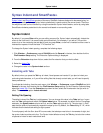
Aliases
Aliases are identifiers that you can quickly type which are then expanded into snippets of text. You can
use aliases for commonly typed function names, statements, or to insert several lines of code. There are
two types of aliases in SlickEdit® Core:
• Directory Aliases - Directory aliases are short identifiers for long directory names. They save you from
having to type long path names when you are prompted for a file name or directory.
• Extension-Specific Aliases - These aliases are set up on a per-language basis, and are useful for in-
serting frequently used text, such as comment headers, into your code.
Directory Aliases
Directory aliases take advantage of the fact that most users are constantly opening files from a small
number of directories throughout the day. By using a directory alias when opening a file or changing dir-
ectories, you do not have to type in long paths or click the mouse repeatedly in the Directory list box.
After typing the alias identifier, directory aliases can be expanded by pressing Ctrl+Space. These aliases
are stored in the file alias.slk.
Note
SlickEdit Core doesn't modify Eclipse's file management-related dialogs such as File → Open,
File → Save As. Therefore, directory aliases are not available in these dialogs.
Defining a New Directory Alias
Directory aliases typically consist of a short abbreviation of the last name in a long directory path. For ex-
ample, if you had a directory called c:\version20\src\project2\, a good alias name might be p2.
For compiler include files, define an alias called inc (vinc in Microsoft Visual C++, binc in C++ Builder®,
or ginc for GCC) if you have multiple compilers.
To define a new directory alias, complete the following steps:
1. From the main menu, click Window → Preferences, expand SlickEdit and click General in the tree,
then double click the Alias setting. The Select Alias File dialog appears.
Figure 6.19. Select Alias File Dialog
Directory Aliases
150


















